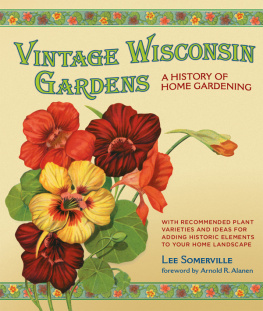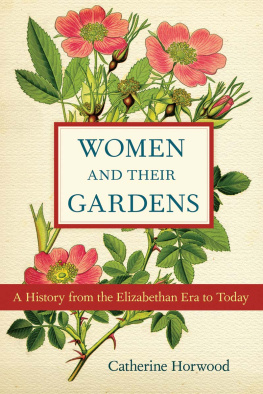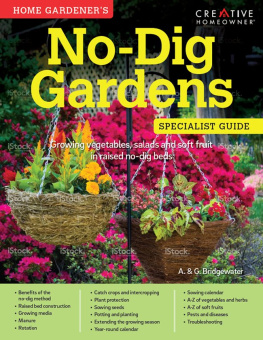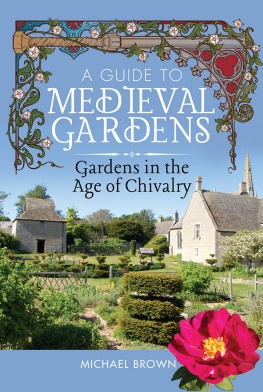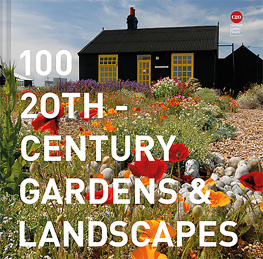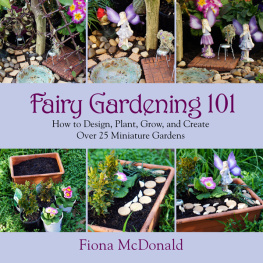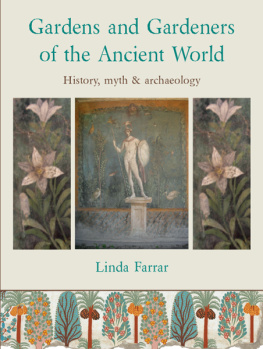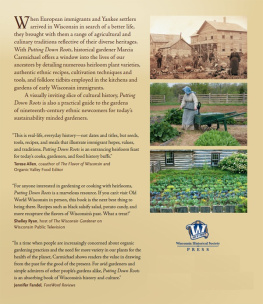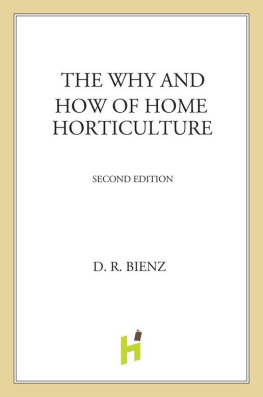
Published by the Wisconsin Historical Society Press
Publishers since 1855
2011 by the State Historical Society of Wisconsin
E-book edition 2013
For permission to reuse material from Vintage Wisconsin Gardens: A History of Home Gardening, (ISBN 978-0-87020-475-3; e-book ISBN 978-0-87020-658-0), please access www.copyright.com or contact the Copyright Clearance Center, Inc. (CCC), 222 Rosewood Drive, Danvers, MA 01923, 978-750-8400. CCC is a not-for-profit organization that provides licenses and registration for a variety of users.
wisconsin history .org
Photographs identified with WHi or WHS are from the Societys collections; address requests to reproduce these photos to the Visual Materials Archivist at the Wisconsin Historical Society, 816 State Street, Madison, WI 53706.
Back cover: WHi Image ID 27008
Frontmatter photo credits: : Vicks Monthly Magazine, November 1879.
Designed by Steve Biel
15 14 13 12 11 1 2 3 4 5
The Library of Congress has cataloged the printed edition as follows:
Somerville, Lee.
Vintage Wisconsin gardens : a history of home gardening / Lee Somerville ; foreword by Arnold R. Alanen.
p. cm.
Includes bibliographical references and index.
ISBN 978-0-87020-475-3 (pbk. : alk. paper) 1. GardeningWisconsinHistory. 2. GardensWisconsinHistory. I. Title.
SB451.34.W6S66 2011
635.909775dc22
2011001830

Dedicated to Wisconsin gardeners,
past, present, and future
Contents
Foreword
Any observant person who travels throughout present-day Wisconsin cannot help but notice that well-tended, orderly, and often imaginative gardens, yards, and lawns appear in abundance throughout the state. Whether in rural, suburban, or urban areas, many Wisconsin residents take a strong interest in creating, making, and maintaining the outdoor spaces that serve as settings for their homes and farmsteads.
The origins of these present-day residential spaces, which collectively form a major portion of the states overall cultural landscape, may be traced back to the mid-nineteenth centurya time when some areas of Wisconsin began to undergo the transition from frontier conditions to a more domesticated and civilized environment. Granted, the changes did not occur overnight, even as Wisconsin achieved statehood in 1848 and its population expanded from 31,000 in 1840 to 776,000 in 1860. During this twenty-year period Wisconsins American- and foreign-born residents mined ore, developed townsites, and cleared land for agricultural purposes. Following the end of the Civil War in 1865, the foundation for Wisconsins quintessential dairy farm landscape began to emerge, and its towns and cities attracted increasing numbers of inhabitants. By 1920, when the population total exceeded 2.6 million people, the states settlement framework was in place, and Wisconsin was fully integrated into all facets of national life and activity. It is the period described above, from the 1840s to 1930, that Lee Somerville covers in Vintage Wisconsin Gardens: A History of Home Gardening.
Unlike the majority of American garden history books, which focus on formal and high style examples, this volume features vernacular gardensthe outdoor spaces that Wisconsinites themselves created for their own use and enjoyment. For the most part, these people did not have access to a professional landscape designer, or the monetary resources to hire one; however, there was an organization that could provide them with free garden-related advice: the Wisconsin State Horticultural Society, formed during the mid-nineteenth century. Of special importance to people who wished to enhance their garden knowledge were the proceedings that appeared after each WSHS annual meeting, and which members received from 1869 to 1928. It is the WSHS literature that Lee has thoroughly reviewed, classified, and summarized in developing this account of Wisconsins residential gardens and horticultural practices.
The book concludes with two chapters that will prove especially useful to anyone involved in or contemplating the restoration, development, or interpretation of a period garden in Wisconsin. After offering a consolidated listing of plants recommended by the WSHS for a successful garden, the subsequent chapter discusses steps for implementation. Although implementation may appear challenging, Lee provides a reasonable and clearly understandable set of guidelines to take one through the process. For those who still feel intimidated or overwhelmed by this task, Lee offers reassuring words: any historical garden, she writes, is a representation of the past that can never be entirely accurate.
Vintage Wisconsin Gardens reflects Lees lifetime of horticultural experience, coupled with several years of research and writing. Born and raised in Englanda country whose citizens are noted for their love of gardens and gardeningLee brought her knowledge and interests to Wisconsin, where she successfully adapted them to a different plant palette and a harsher climate. In addition, she gained significant hands-on experience as a historical interpreter and gardener at Heritage Hill State Historical Park in Green Bay and at Old World Wisconsin in Eagle. Those of us who call Wisconsin home are indebted to Lee for devoting her skill, time, and energy to the task of cultivating a greater understanding of our states garden heritage.
Arnold R. Alanen, professor emeritus,
Department of Landscape Architecture, University of WisconsinMadison

LEE SOMERVILLE is a landscape historian and master gardener. Originally from Liverpool, England, her home for the past thirty-five years has been northeastern Wisconsin. Between 1985 and 2001, Somerville was a volunteer at Heritage Hill State Historical Park in Green Bay, where she helped develop garden and landscape plans and organized volunteers to maintain those gardens. She recently received her masters degree in landscape architecture from the University of WisconsinMadison. The research she completed for her thesis on nineteenth-century Wisconsin garden history served as the basis for this book.
Acknowledgments
This undertaking is the fulfillment of a goal I have had for many years: to provide a useful garden history for Wisconsin gardeners, especially those who work at historic sites. I am indebted to all those who helped me shape my research and encouraged my vision.
There are too many to list by name, but the following were especially supportive:
Professors Arnold R. Alanen, Janet C. Gilmore, and Anna V. Andrzejewski, who guided me through my research while I was a graduate student in the Department of Landscape Architecture at the University of WisconsinMadison.
The volunteers and staff of Heritage Hill State Historical Park in Green Bay and Old World Wisconsin in Eagle, who graciously allowed me to wander through their sites, buildings, and archives.
The Wisconsin Master Gardener Association, especially the members of my home Door County group, and those who garden at the many historic sites throughout the state.
My editor, Laura Kearney, who patiently corrected my convoluted syntax and grammar, shortened my sentences, and made me find answers to questions I had been avoiding. Mike Nemer, who expertly shepherded the book through the production process and attended to the details. And the books designer Steve Biel, who used his gardeners eye to integrate the text and the photographs into such colorful harmony.
Next page
